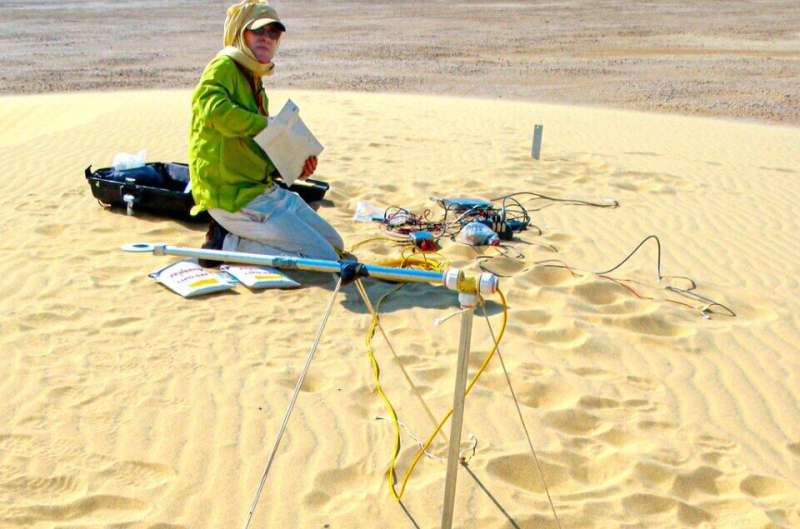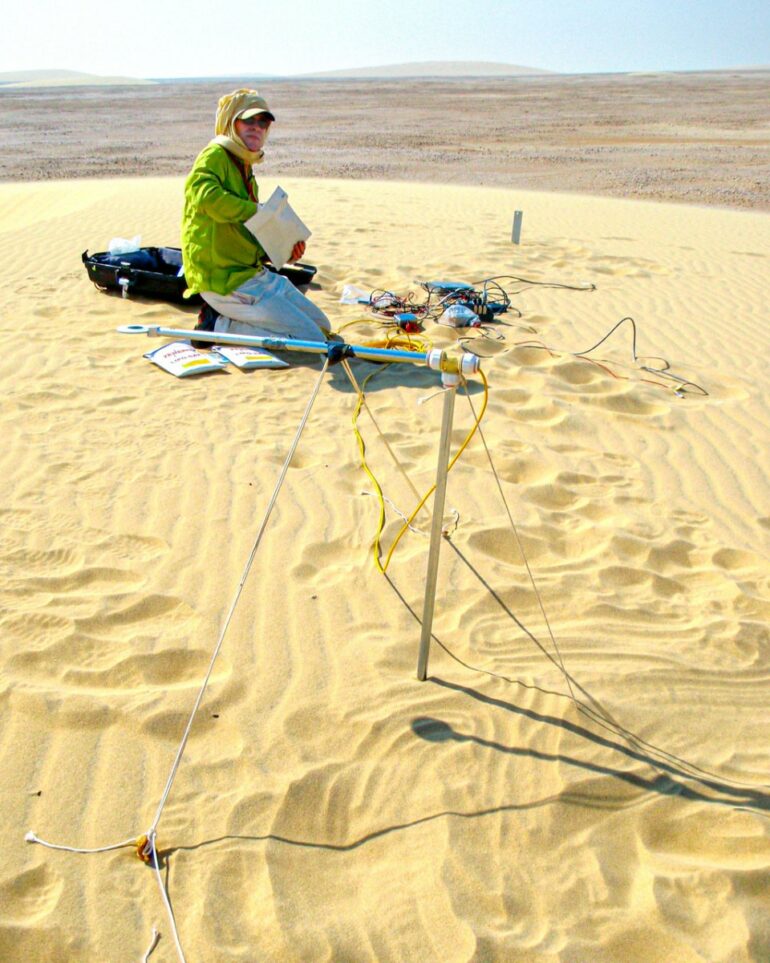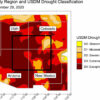Deserts may seem lifeless and inert, but they are very much alive. Sand dunes, in particular, grow and move—and according to a decades long research project, they also breathe humid air.
The findings show for the first time how water vapor penetrates powders and grains, and could have wide-ranging applications far beyond the desert—in pharmaceutical research, agriculture and food processing, as well as planetary exploration.
The team’s paper, “Water Vapor Transport Across an Arid Sand Surface—Non-Linear Thermal Coupling, Wind-Driven Pore Advection, Subsurface Waves, and Exchange with the Atmospheric Boundary Layer,” published March 21 in the Journal of Geophysical Research: Earth Surface.
The project, led by lead author Michel Louge, professor of mechanical and aerospace engineering in the College of Engineering, has spanned not only a great deal of time but also a variety of terrain. It began nearly 40 years ago, when Louge was studying the behavior of fluids, gasses and solid particles.
Wanting to measure matter with greater sensitivity, he and his students developed a new form of instrumentation called capacitance probes, which use multiple sensors to record everything from solid concentration to velocity to water content, all with unprecedented spatial resolution.
When a colleague at the University of Utah suggested the technology might be helpful in imaging the layers of mountain snow packs and assessing the likelihood of avalanches, Louge went to his garage, grabbed some probes and tested them out in a snowstorm. Soon he struck up a partnership with a company, Capacitec Inc, to combine their respective skills in geometry and electronics. The resulting probes also proved useful in hydrology research.
In the early 2000s, Louge began collaborating with Ahmed Ould el-Moctar from University of Nantes, France, to use the probes to study the moisture content in sand dunes to better understand the process by which agricultural lands turn to desert—an interest that has only become more urgent with the rise of global climate change.
“The future of the Earth, if we continue this way, is a desert,” Louge said.
Whereas other probes can measure large volumes of matter, Louge’s probes go deep and small, collecting data on a millimetric scale to pinpoint the exact amount of moisture in—and the density of—sand. To function in a new environment, though, the probes needed to be modified. And so began a decade long process of trial and error, as Louge made periodic trips to deserts in Qatar and Mauritania experimenting with different versions of the probe.

Michel Louge, professor of mechanical and aerospace engineering, pictured here in Qatar in 2012, has been using capacitance probes to study the moisture content in sand dunes since the early 2000s. © Cornell University
The probe eventually revealed just how porous sand is, with a tiny amount of air seeping through it. Previous research had hinted this type of seepage existed in sand dunes, but no one had been able to prove it until now.
“The wind flows over the dune and as a result creates imbalances in the local pressure, which literally forces air to go into the sand and out of the sand. So the sand is breathing, like an organism breathes,” Louge said.
That “breathing” is what allows microbes to persist deep inside hyper-arid sand dunes, despite the high temperature. For much of the last decade, Louge has been collaborating with Anthony Hay, associate professor of microbiology in the College of Agriculture and Life Sciences, to study how microbes can help stabilize the dunes and prevent them from encroaching into roads and infrastructure.
Louge and his team also determined that desert surfaces exchange less moisture with the atmosphere than expected, and that water evaporation from individual sand grains behaves like a slow chemical reaction.
The bulk of their data was gathered in 2011, but it still took Louge and his collaborators another decade to make sense of some of the findings, such as identifying disturbances at the surface level that force evanescent, or nonlinear, waves of humidity to propagate downward through the dunes very quickly.
“We could have published the data 10 years ago to report the accuracy of our approach,” Louge said. “But it wasn’t satisfying until we understood what was going on. Nobody really had done anything like this before. This is the first time that such low levels of humidity could be measured.”
The researchers anticipate their probe will have a number of applications—from studying the way soils imbibe or drain water in agriculture, to calibrating satellite observations over deserts, to exploring extraterrestrial environments that may hold trace amounts of water. That wouldn’t be the first time Louge’s research made its way into space.
But perhaps the most immediate application is the detection of moisture contamination in pharmaceuticals. Since 2018, Louge has been collaborating with Merck to use the probes in continuous manufacturing, which is viewed as a faster, more efficient and less expensive system than batch manufacturing.
“If you want to do continuous manufacturing, you have to have probes that will allow you, as a function of time, and everywhere that’s important, to check that you have the right behavior of your process,” Louge said.
More information:
M. Y. Louge et al, Water vapor transport across an arid sand surface ‐ non‐linear thermal coupling, wind‐driven pore advection, subsurface waves, and exchange with the atmospheric boundary layer, Journal of Geophysical Research: Earth Surface (2022). DOI: 10.1029/2021JF006490
Provided by
Cornell University
Citation:
Deserts ‘breathe’ water vapor, study shows (2022, March 30)



